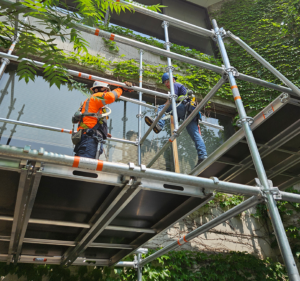A contractor's guide to navigating municipal and provincial regulations. Use our interactive tool to understand your project's specific compliance needs and avoid costly delays.
View Compliance ChecklistDo You Need a Permit for Scaffolding in Toronto? A Compliance Checklist
Scaffolding compliance in Toronto involves multiple permits and regulations depending on your project's location, scope, and height. Review the checklist below to understand the potential requirements for your worksite.
Potential Scaffolding Permit & Safety Requirements
Provincial Safety (OHSA)
Applies to ALL projects. You must follow O. Reg. 213/91 for scaffold erection, use, and daily inspections. This is your non-negotiable foundation for worker safety.
Street Occupation Permit
Required if your work encroaches on public property. This permit from Toronto Transportation Services is needed for any scaffold on a sidewalk, road, or lane. It involves detailed plans and fees.
Building Permit
Required for the construction work itself. If your project involves major alterations or a new build, a Building Permit from Toronto Building is necessary. Your scaffolding plan must align with your site plans.
Right of Entry Permit
Required if you need access to a neighbour's property. This formal permit from the City is necessary to protect all parties and manage liability when erecting scaffolding from an adjoining lot.
Professional Engineer Design
Required for tall or complex scaffolds. Due to its height (e.g., over 10m or 15m) or complexity, your scaffold must be designed by a licensed Professional Engineer (P.Eng.) as per provincial law.
Toronto's Three-Tiered Compliance Framework
Compliance is not a single permit but a matrix of obligations. A single project is subject to regulations from multiple tiers simultaneously. Understanding this is the key to avoiding fines and stop-work orders.
1. Municipal (Location-Based)
Governed by Transportation Services. The Street Occupation Permit is triggered whenever your work occupies the public right-of-way (sidewalk, road, lane). Focus is on public space management.
2. Municipal (Work-Based)
Managed by Toronto Building. The Building Permit is required for the construction or alteration work itself, not the scaffold. Ensures compliance with the Ontario Building Code.
3. Provincial (Safety-Based)
Enforced by the Ministry of Labour via the OHSA. Dictates non-negotiable standards for how every scaffold is designed, erected, inspected, and used. This applies universally to all projects.
Permit & Safety Deep Dive
Explore the details behind Toronto's scaffolding regulations. Use this information to plan your project effectively and ensure full compliance.
Street Occupation Permit Fees (2025 Rates)
Fees are a significant project cost and vary by location. Use this table for budgeting. Occupying a roadway is significantly more expensive than a sidewalk.
| Description | In Construction Hub | Outside Hub |
|---|---|---|
| Site Protection Application | $974.30 | $779.45 |
| Lifetime Project Fee (per linear metre) | $32.90 | $26.35 |
| Monthly Sidewalk Occupation (per m²) | $10.98 | $8.78 |
| Monthly Roadway Occupation (Area AA, per m²) | $243.38 | $194.70 |
Key OHSA Safety Metrics (O. Reg. 213/91)
These are non-negotiable safety standards for every scaffold in Ontario. Documenting compliance is your primary defense against liability.
- ✓Load Capacity: Must support 4x the intended load without overturning, and 2x without component failure.
- ✓Stable Foundation: Must be built on solid ground with base plates and mud sills.
- ✓Height-to-Base Ratio: Must not exceed 3:1 unless securely tied to the building.
- ✓Guardrails: Required for any platform where a worker could fall 2.4m (8 ft) or more.
- ✓Safe Access: A proper ladder or stairway must be provided. Climbing cross-braces is forbidden.
When is an Engineer's Design Required?
Provincial law mandates a Professional Engineer's involvement for taller, more complex scaffolds to ensure structural integrity. This is a critical compliance point.
Risk, Liability, and Due Diligence
Compliance is about more than avoiding fines, it's about managing profound financial, legal, and human risk. A shortcut can lead to devastating consequences.
The True Cost of a Shortcut: The Metron Case
The 2009 Metron Construction tragedy, where four workers died in a scaffold collapse, set a crucial legal precedent. The investigation found clear violations of OHSA safety protocols, leading to charges of criminal negligence causing death.
This case established that when an employer shows reckless disregard for worker safety by ignoring provincial regulations, a workplace accident can be elevated from a regulatory matter to a criminal offence. The potential penalties are not just fines, but life prison terms for individuals found responsible.
The safety standards in O. Reg. 213/91 are not suggestions. They are the legal line between a compliant worksite and the risk of criminal prosecution.






One Response